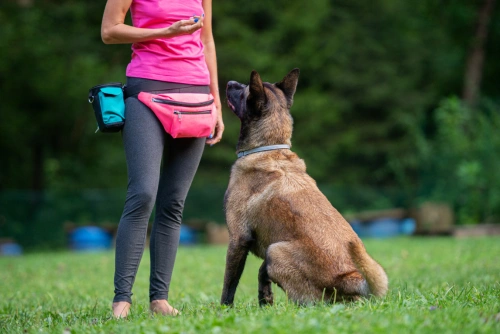Key Takeaways
-There are no regulations determining who can claim to be a dog trainer. Therefore, anyone can call themselves a dog trainer.
– Despite the dog training industry being largely unregulated, there are respected credentials within the industry.
– Pet owners will surely want to look for trainers that use Fear Free, Force Free, LIMA, and Low-Stress Handling techniques; all of which utilize Positive Reinforcement.
– There are about 10 dog trainer certifications to look for in a trainer.
– There are about 8 behavioral consultant certifications to look for in a trainer.
– For pets with concerning behavioral issues, a pet owner may require the services of a veterinary behaviorist through the DACVB, AVSAB, or AVBT.
– Owners should develop a list of important questions to ask potential trainers to ensure they are the right fit for a particular pet.
– Avoid trainers that do not have the specified certifications and use pain and punishment, negative reinforcement, and fear-based techniques. E-collars, prong collars, electric fences are all examples.
– Research shows positive reinforcement works better than other training methods. Even pain, punishment, and fear-based methods can sometimes be effective, but quite possibly with the tradeoff being an increase in fear, anxiety, stress, and aggression. All of which reduce an animal’s welfare.
Hiring a qualified dog trainer is a big decision that can impact your pet’s happiness and behavior. However, the dog training industry is largely unregulated, meaning anyone can call themselves a trainer. Therefore, without clear guidelines for certification, it’s up to you as a pet owner to ensure your trainer is qualified. This guide will certainly help you choose a trainer who uses humane, science-based methods to support your dog’s wellbeing.
Why Does Certification Matter in Dog Training?
Not all trainers follow the same standards or methods. In fact, some use outdated techniques like shock collars, prong collars, or punishment-based training. While these methods might seem effective at first, research shows they can increase stress, fear, and aggression in dogs. They also violate the Five Freedoms of Animal Welfare, including freedom from fear and pain.
On the other hand, trainers with proper certifications contrarily prioritize positive reinforcement and humane methods. These approaches teach dogs what to do instead of punishing them for unwanted behavior. Ultimately, this leads to better outcomes and strengthens the bond between you and your dog.
Training Method Terminology to Look For
When evaluating a trainer, their methods matter just as much as their credentials. The best trainers rely on science-backed, humane techniques that prioritize the well-being of your dog. Here are the most effective and compassionate methods used by qualified professionals to look for:
Fear Free
Fear Free training minimizes fear, anxiety, and stress in pets during training and other interactions. Trainers certified in Fear Free methods are experts in recognizing and reducing stress signals, ensuring a more enjoyable experience for your dog.
Force-Free Training
Force-free training eliminates the use of physical punishment, intimidation, or aversive tools like shock collars and prong collars. Instead, it focuses on building trust and cooperation through positive reinforcement and clear communication.
LIMA (Least Intrusive, Minimally Aversive)
LIMA emphasizes using the least intrusive and minimally aversive techniques to achieve desired behaviors. This strategy prioritizes positive reinforcement while ensuring your dog’s welfare is never compromised. Trainers using LIMA methods aim to teach your dog what to do rather than focusing on punishment for undesired behaviors.
Low-Stress Handling
Low-stress handling focuses on humane techniques to manage and train dogs with minimal stress. This approach involves understanding canine body language, respecting boundaries, and creating a safe and calm training environment.
Positive Reinforcement
Positive reinforcement focuses on rewarding desired behaviors, encouraging your dog to repeat them. This method is highly effective and strengthens the bond between you and your pet. Reinforcements can include treats, praise, toys, or anything your dog finds motivating. A qualified dog trainer must use positive reinforcement.
Dog Trainer Certifications to Look For
When evaluating dog trainers, check for credentials from respected organizations. Below is a comprehensive list of reliable certifications for dog trainers, behavioral consultants, and veterinary behaviorists. If a trainer has one or more of these credentials, chances are they are a qualified dog trainer.
Dog Trainer Certifications
- CTC (Certificate in Training and Counseling): Offered by the Academy for Dog Trainers, this is one of the most respected certifications in the field.
- Canine Training Technician Accredited (CTT-A): This certification indicates in-depth training knowledge through the Pet Professional Guild’s Pet Professional Accreditation Board.
- CATCH Canine Trainers Academy Certified Dog Trainer (CDT): Emphasizes humane and science-based training methods.
- Certified Professional Dog Trainer – Knowledge Assessed (CPDT-KA): A Certification Council for Professional Dog Trainers’ certification requiring at least 300 hours of training experience within the last 3 years and passing a comprehensive exam.
- Certified Professional Dog Trainer – Knowledge & Skills Assessed (CPDT-KSA): Builds on CPDT-KA by testing hands-on skills.
- • FFCP (Fear Free Certified Professional): A Fear Free Animal Trainer must already hold one of the certifications listed in this article to qualify for the program.
- Karen Pryor Academy Certified Training Partner (KPA CTP): Focuses on positive reinforcement and clicker training.
- Pat Miller Certified Trainer (PMCT): Reflects expertise in force-free and humane training methods
- Professional Canine Trainer Accredited (PCT-A): Demonstrates mastery in positive training methods through the Pet Professional Guild’s Pet Professional Accreditation Board.
- Victoria Stilwell Academy Graduate or Positively Dog Training Approved Member: Highlights high quality training based on humane, positive reinforcement techniques with members held to the highest standards or professional and ethical conduct.
Behavioral Consultant Certifications

If your dog has complex behavioral issues, consider working with a behavioral consultant or behaviorist. Look for these certifications:
- Animal Behavior College Certified Dog Trainer (ABCDT) or Certified Cat Trainer (CCT): Ensures expertise in addressing behavioral challenges using LIMA (least invasive minimally aversive) techniques.
- Certified Applied Animal Behaviorist (CAAB): Advanced degree-holders (PhD, DVM, or VMD) with extensive experience in behavior analysis of at least 5 years professional experience plus 2 years of residency along with an additional 3 years of experience in applied animal behavior. Find a CAAB on the Animal Behavior Society’s directory.
- Associate Certified Applied Animal Behaviorist (ACAAB): A similar qualification as the CAAB for those with a master’s degree, though this credential requires only 2 years of applied animal behavior experience along with at least 3 letters of recommendation from other animal behavior professionals.
- Certified Dog Behavior Consultant (CDBC) or Certified Cat Behavior Consultant (CCBC): an International Association of Animal Behavior Consultants’ (IAABC) certification, these trainers require a minimum of 4 years of hands-on experience with 500 hours of consulting work and 400 hours of coursework. Additional IAABC behavior certifications include CEBC (equine), CPBC (parrot), CSB-D (shelter dogs), and CSB-C (shelter cats)
- Certified Behavior Consultant Canine – Knowledge Assessed (CBCC-KA): A Certification Council for Professional Dog Trainers’ certification that focuses on applied behavior modification strategies.
- Delta Institute Certificate IV in Animal Behavior and Training: A 2-year vocational training program in Australia focused on positive reinforcement training.
- Dogma Certified Behavior Consultant (DCBC): Demonstrates behavioral expertise and practical skills. To qualify, one must work for 2 years with another professional trainer acquiring 450 hours of work in 12 months. Candidates must also receive either a CPDT-KA, KPA CTP, DDT, CCDT, or ABCDT within 2 years after completion.
- Professional Canine Behavior Consultant Accredited (PCBC-A): Recognizes advanced knowledge in behavior modification and canine psychology through the Pet Professional Guild’s Pet Professional Accreditation Board.
Veterinary Behaviorist Certifications

For severe behavioral concerns rooted in health issues, consult a veterinary behaviorist. If uncertain where to find one, talk with your own veterinarian for recommendations. Key credentials include:
- Diplomate of the American College of Veterinary Behaviorists (DACVB): Indicates a veterinarian with advanced behavioral training. There are only about 80 in the entire world. Use the DACVB directory to find a diplomate.
- American Veterinary Society of Animal Behavior (AVSAB) Member: A veterinarian or PhD that demonstrates expertise in both veterinary medicine and animal behavior. Find a member on the AVSAB directory.
- Veterinary Technician Specialist in Behavior (VTS): Combines superior veterinary knowledge with behavioral expertise following scientific and humane techniques. You can search for a VTS using the AVBT member directory.
What Questions Should You Ask a Trainer?

Before hiring a trainer or behaviorist, ask thoughtful questions to determine their qualifications and methods. Here are a few examples:
- What training methods do you use?
Look for trainers who emphasize positive reinforcement, low-stress handling, and fear-free techniques. - What are your credentials?
Ensure they hold certifications from respected organizations like those listed above. - Do you have experience with my dog’s breed or specific issue?
Specialized experience can be helpful for certain breeds or behavioral challenges. - Can you provide client references?
Reputable trainers should be able to share testimonials or success stories.
Red Flags to Avoid
Be cautious of trainers who:
- Use punishment-based tools like shock collars, prong collars, or electric fences.
- Focus on what your dog shouldn’t do without teaching alternative behaviors.
- Skip foundational steps like assessing your dog’s needs or scheduling meet-and-greets.
- Lack professional credentials or refuse to explain their methods.
Why Positive Reinforcement is Best

Research consistently shows that positive reinforcement is more effective and humane than punishment-based techniques. A study published in Frontiers in Veterinary Science found that positive reinforcement improves learning outcomes and strengthens the human-dog bond.
By reinforcing desired behaviors, dogs evidently learn faster and experience less stress. Positive training also supports the Five Opportunities to Thrive, which focus on creating safe, enriching, and low-stress environments for pets. As mentioned earlier, a qualified dog trainer will certainly use positive reinforcement.
Final Tips for Choosing the Right Trainer
- Plan ahead. Take time to research and interview trainers. Avoid last-minute decisions.
- Check credentials. Look for trainers with certifications aligned with humane, science-backed methods.
- Trust your instincts. Watch how a trainer interacts with your dog. Your pet should feel safe and comfortable.
Choosing a qualified dog trainer ensures your dog receives the best care and support. By prioritizing humane methods and verified credentials, you’ll create a positive training experience that benefits both you and your furry friend.
